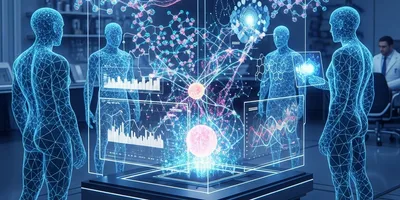In the rapidly evolving world of biomedical science, the demand for speed, innovation, and interdisciplinary collaboration has never been higher. Traditionally, assembling a research team with diverse expertise—from immunology to protein engineering—was a logistical and financial challenge. Enter the age of AI scientists: intelligent agents that collaborate virtually to solve complex scientific problems with unprecedented speed and accuracy.
AI scientists are large language model (LLM)-powered agents designed to emulate the reasoning and decision-making capabilities of human researchers. Recently, researchers at the Chan Zuckerberg Biohub San Francisco (CZ Biohub SF) and Stanford University developed a groundbreaking Virtual Lab platform that uses these AI agents to form dynamic, multidisciplinary research teams. These agents conduct virtual experiments, analyze outcomes, and generate hypotheses—all under the direction of a human-defined Principal Investigator (PI) agent.
The implications of this development are profound. Not only does it democratize access to elite-level research teams, but it also represents a paradigm shift in how scientific discoveries are made.
How AI Scientists Work in the Virtual Lab Platform
Building a Team of AI Scientists
At the heart of the Virtual Lab is the creation of a PI agent, which functions as the lead researcher. The PI then assembles a team of specialized AI agents, each mimicking a distinct role commonly found in a biomedical laboratory, such as:
- Virologist Agent
- Immunologist Agent
- Bioinformatician Agent
- Protein Engineer Agent
Each agent is powered by an LLM that enables deep scientific reasoning. Their collective goal is to address an open-ended scientific question posed by a human researcher.
A Novel Collaboration Workflow
Once the research question is defined, the agents engage in structured discussions, propose research methodologies, and iterate on results. The team also includes a Scientific Critic Agent—a generalist tasked with asking probing questions and curbing hallucinations. This ensures the team maintains scientific rigor and avoids illogical conclusions.
Importantly, human intervention is minimal. According to the developers, human input constituted only about 1% of the total dialogue. Most of the intellectual heavy lifting is handled autonomously by the AI agents.
AI Scientists Tackle SARS-CoV-2 Nanobody Design
Research Objective
To evaluate the effectiveness of their platform, the Virtual Lab team tackled a high-stakes biomedical problem: designing Nanobodies capable of binding to the spike protein of emerging SARS-CoV-2 variants.
Lab Quality Management Certificate
The Lab Quality Management certificate is more than training—it’s a professional advantage.
Gain critical skills and IACET-approved CEUs that make a measurable difference.
Computational Pipeline Design
Within days, the AI scientists devised a computational pipeline to design and screen Nanobody candidates. Key techniques and technologies employed included:
- Molecular Docking Simulations
- Protein Structure Prediction
- Binding Affinity Modeling
This rapid development led to the generation of 92 Nanobody blueprints, a process that would typically take weeks or even months for a human team.
Real-World Validation
Two of the designed Nanobodies demonstrated strong binding to the spike protein of new viral strains during subsequent lab experiments conducted by John Pak’s team at CZ Biohub SF.
"The AI agents came up with a pipeline that was quite creative. But at the same time, it wasn’t outrageous or nonsensical. It was very reasonable—and they were very fast." —John Pak
Key Technologies Behind AI Scientists in Research
AI Agents and Their Functions
| Agent Role | Primary Function |
|---|---|
| PI Agent | Oversees the project and directs other agents |
| Specialist Agents | Execute domain-specific tasks (virology, bioinformatics, etc.) |
| Scientific Critic Agent | Ensures logical consistency and reduces hallucinations |
Technologies Used
- Large Language Models (LLMs) for scientific reasoning
- Simulated Molecular Modeling for virtual experiments
- Transcript Review Systems for human transparency
Human-AI Collaboration
Though largely autonomous, the system allows human scientists to review AI agent conversations and outcomes. This transparency alleviates concerns about "black box" decision-making and fosters trust in the AI-generated data.
"The agents and the humans are all speaking the same language, so there’s nothing 'black box' about it..." —John Pak
Benefits of Using AI Scientists in Biomedical Labs
Accelerating Discovery
The Virtual Lab's success in solving a challenging protein design problem highlights its potential to accelerate discovery timelines. Tasks that traditionally spanned months can now be completed in days.
Democratizing Research
With fewer resources required, smaller institutions and independent researchers can now undertake complex, interdisciplinary projects without needing a full human research team.
Enhancing Human Creativity
Far from replacing scientists, AI scientists act as powerful collaborators that generate more testable hypotheses.
"This project opened the door for our Protein Science team to test a lot more well-conceived ideas very quickly... It gave us more work, in a sense, because it gave us more ideas to test." —John Pak
The Future of AI Scientists in Scientific Discovery
Expanding Beyond Biomedical Fields
While the current iteration of the Virtual Lab is tailored for biomedical applications, the developers believe the system can be adapted for a wide range of scientific disciplines, including:
- Environmental Science
- Material Engineering
- Astrophysics
A New Paradigm in Research
"We’re demonstrating a new paradigm where AI is not just a tool we use... it can actually be a primary driver of the whole process to generate discoveries." —James Zou
The collaboration between human and AI scientists is poised to redefine the structure of research teams and the pace of innovation. By leveraging diverse AI perspectives, researchers can uncover solutions that might otherwise be overlooked.
Final Thoughts on AI Scientists
The Virtual Lab initiative by CZ Biohub SF and Stanford University marks a pivotal moment in the integration of AI into biomedical research. By assembling virtual teams of AI scientists capable of autonomous reasoning and collaboration, researchers can tackle pressing scientific questions with newfound efficiency and creativity.
This innovation represents more than just a technological breakthrough—it heralds a fundamental shift in how science is conducted, making high-impact research more accessible, collaborative, and scalable than ever before.













